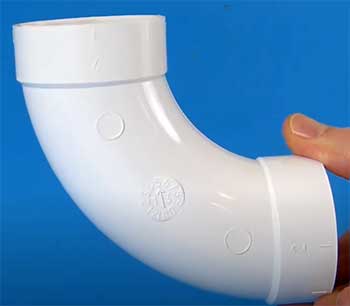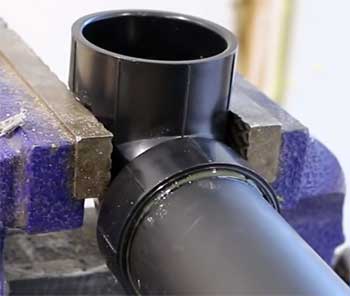A flawless drainage system is essential for every house because no one wants a leak or clog in their pipe. If you remodeled your house’s drainage system or established a drainage system for your home, you might have heard about the sweep.
Finding the right kind of sweep for the drainage system is not easy, and you might get confused about long sweep 90 vs. short sweep.
Go through this article to the end, and you will be able to make the right decision all by yourself.
A Quick Comparison Table
Here’s a quick comparison between long sweep 90 and short sweep for your better understanding –
| Specifications | Long Sweep 90 | Short Sweep |
| Direction of the pipe | Vertical to Horizontal and Horizontal to Horizontal | Horizontal to Vertical |
| Application | Drain and vent system | Mostly in the vent system |
| Uses in Toilet | Yes | Yes |
| OD( Outside Diameter) | 2″ to 7″ | 2″ to 6″ |
| Pressure | Creates high pressure | Reduce the pressure |
| Radius | Long inside and outside radius | Short inside and outside radius |
| Material | PVC and metal | PVC and metal |
| Cleanout | Can be used with cleanout | Can not be used with cleanout |
Long Sweep 90

A long sweep 90 is also known as long sweep tee, long sweep elbow, or long radius elbow.
In DWV (Drain, Waste, Vent) system, long sweep 90 works like a bridge that is used for changing the direction of the flow with proper pressure.
You can easily find this type of sweep in the multi-story house or commercial building where this sweep helps to direct the water from the upper floor to the main drain line.
It has a bigger radius both inside and outside, and when used in the middle of horizontal and vertical pipe, it creates a 90-degree angle. That’s why it is called long sweep 90.
The long sweep 90-degree fitting has a longer, more gently curved path than a short sweep 90. This makes it ideal for use on a toilet drain line.
Smoother Waste Flow
The defining benefit of the long sweep 90 is it allows waste to make the 90-degree turn without slowing down. The large radius curve minimizes turbulence and friction compared to a tight turn.
This unimpeded flow helps efficiently move solids down the drain. It also reduces the chance of backups and clogs by preventing waste from getting caught in the fitting.
Less Potential for Clogs
In addition to the smooth curve, a long sweep 90 has a larger inside diameter than a short sweep. This further reduces the risk of clogs forming.
The long sweep 90’s generous 3-4″ diameter provides ample room for solid waste to pass through. It’s less likely that debris gets snagged in the fitting compared to a standard 2″ short sweep 90 drain opening.
Optimized for Toilet Waste
While most household drains require a 90-degree fitting, toilets have the largest flow rates and waste loads. The high volume of water and solids from a flushed toilet demand the large, gently curving long sweep to maintain flow.
Attempting to save a few dollars with a short sweep 90 on a toilet drain often leads to headaches down the road due to clogs. The long sweep is specifically designed for the demands of toilet service.
Easier Cleaning
The optimized waste flow and large diameter of a long sweep 90 fitting also make it easier to clean if needed. A toilet auger has ample open space to feed through and reach any obstructions.
In contrast, a short sweep 90 with ridges and a reduced opening makes augering more difficult. The long sweep’s straighter path allows an auger to reach deeper clogs.
Short Sweep

A short sweep or short sweep elbow is a bent piece of pipe specially used in the vent system.
The inside and outside radius of the sweep is very short. That’s why it is called a short sweep.
Like the long sweep 90, it is also used for changing the direction of the water flow.
A short sweep fitting is a type of drain pipe fitting used to make tight 90 degree turns in plumbing systems. The key features of a short sweep fitting include:
- Tight bend radius – The short sweep makes an abrupt, close-quarter 90 degree turn, usually with a 1-2 inch radius.
- Compact size – Short sweeps allow drains to fit into small spaces by taking up less linear space than a long sweep bend.
- Smaller diameter – Typical short sweep diameters range from 1 1/2 to 2 inches. This matches sink, shower, and branch drain pipe sizes.
- Ridged interior – The short sweep’s interior surface features ridges that guide waste around the tight bend.
- Less expensive – Simple injection molding makes short sweep fittings fast and economical to produce.
But it can not be used in every position of the pipe. In this article, we will talk about this in detail.
So, stick it to the end.
Differences Between Long Sweep 90 And Short Sweep

Here is how they are different from each other:
- Direction of the pipe
You can easily decide which sweep you need to use by identifying the direction of the pipe. If the pipe goes vertical to horizontal and horizontal to horizontal, you need to use a long sweep 90.
But in the case of horizontal to vertical, you should use a short sweep.
Two horizontal pipes cannot be connected via a sanitary tee or a short sweep. Even if you check out the international code of plumbing, you will see that it does not allow sanitary tee or short sweep to connect two horizontal pipes.
You can also check out the UPC (Universal Product Code); it will say the same. Now let us describe to you, why!
Imagine a river with heavy water flow. It is obvious that there will be a smooth flow if the curve is long enough. If the curve is shallow, the flow won’t get enough space, and it will slow down, right?
The same happens when two horizontal pipes get connected with a short sweep for changing the direction. The flow slows down, and if there’s any waste in the water, it gets clogged.
But when the water flows horizontal to vertical, it needs a short sweep to change the direction. Because the water can easily move down from horizontal to vertical pipe, there’s no need to speed up the flow.
Rather you need to slow down the process for a smooth flow. That’s why a short sweep is used in this case.
- Application
We already know that a short sweep actually relieves the pressure. In the venting system, the pipe releases some water pressure in order to conduct the airflow.
That’s why short sweep is mainly used for the venting system.
On the other hand, long sweep 90 is used in both drain and waste pipes because of its mechanism. It speeds up the flow and helps to flow the water’s wastes.
- Uses in Toilet
Both long sweep 90 and short sweep can be used in toilet line. A lot of people think that short sweep 90 for the toilet can cause clogs. But if it’s used between the pipe which goes horizontal to vertical, it won’t be a problem.
- OD and Radius
Most of the companies provide both long sweep 90 and short sweep with different OD (outside diameter). Long sweep 90 comes with 2″ to 7″ and short sweep comes with 2″ to 6″ of OD.
There’s a major difference between long sweep 90 and short sweep that can be noticed in the case of radius. The outside and inside radius both are larger than the short sweep.
You can even put three fingers between the flanges of a long sweep 90. But the short sweep does not have enough room on the inside radius.
- Cleanout
Cleanout is a capped pipe that connects your home’s drainage system to the main sewer line. You can see long sweep 90 with cleanout in the open space outside your house.
A long sweep 90 is used for the cleanout so that it doesn’t get buried on the ground.
This video should clear everything you need to know.
Frequently Asked Questions (FAQ)
You can use a long sweep 90 anywhere of a drain, waste, or vent system. You just have to be aware of the direction of the pipes.
You can use a long sweep 90 if the flow goes horizontal to horizontal and vertical to horizontal.
A short sweep 90 is ideal for the venting system. Because of its short radius, it does not work properly in the drainage and waste system.
There’s a slight chance of clogging when used between two horizontal pipes of a waste system. So, it is better to use the short sweep 90 in the venting system so that it can conduct air.
It depends on whether you’re using a long sweep 90 or a short sweep 90. A short sweep 90 should not be used directly to the toilet pipe. As it has a very shallow bend, it can cause clogs.
Long sweep elbow speeds up the flow and keeps the waste-system free from clogging.
PVC (polyvinyl chloride) is the most ideal material for sanitary drainage piping. PVC pipes come in different sizes, lengths and the best part is you can cut them easily to give the preferable length.
It also deals with the pressure and weight better than other materials.
The long sweep 90 is required by plumbing code for use as the toilet drain fitting. It makes the optimal turn for moving solids from the vertical toilet flange to the horizontal drain line thanks to its wide diameter and gentle curve. Long sweeps are also recommended for any 3-4 inch main waste lines where keeping flow smooth is critical.
Yes, plumbing codes mandate use of a long sweep 90-degree fitting when installing the toilet drain line. The long sweep is specially designed for the high flow rates and loads produced by a toilet flush. Using a short sweep 90 on a toilet often leads to clogs, backups, and flow problems due to the tight turn and smaller diameter. Always check local codes for exact toilet drain fitting requirements.
Final Words
The debate about long sweep 90 vs. short sweep is very common, and the lack of proper knowledge can mislead you. Even many plumbers make mistakes when they use sweeps for the DWV piping.
Whether you’re doing it yourself or having a plumber do the job, choose wisely between the long sweep 90 and short sweep. Analyze the directions of the flow and select the sweeps according to that.
A long sweep 90 works with most of the directions even when the flow is from horizontal to vertical pipe. So, when in doubt, pick long sweep 90.
